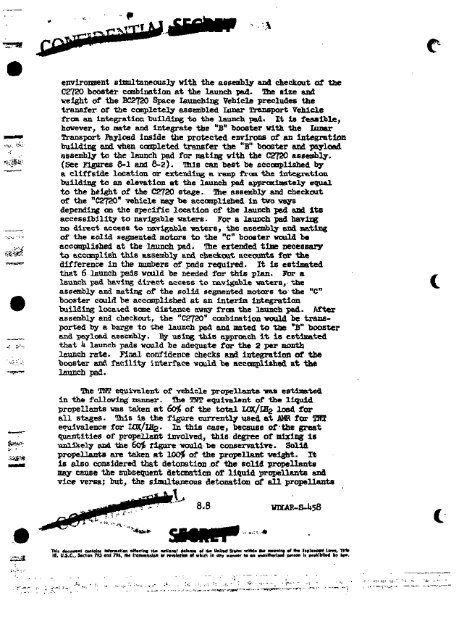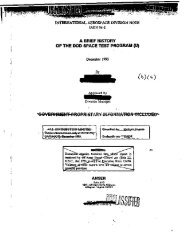LUNAR EXPEDITION PLAN
LUNAR EXPEDITION PLAN
LUNAR EXPEDITION PLAN
Create successful ePaper yourself
Turn your PDF publications into a flip-book with our unique Google optimized e-Paper software.
environment simultaneously with the assembly and checkout of the<br />
C2720 booster combination at the launch pad. The else and<br />
weight of the BC2720 Space Launching Vehicle precludes the<br />
transfer of the completely assembled Lunar Transport Vehicle<br />
from an integration building to the launch pad. It Is feasible^<br />
however, to mate and Integrate the "B" booster with the lunar<br />
Transport Payload Inside the protected environs of an Integration<br />
building and vhen completed transfer the "B" booster and payload<br />
assembly to the launch pad for mating with the C2720 assembly.<br />
(See Figures 8-1 and 8-2). This can best be accomplished by<br />
a ellffslde location or extending a ramp from the integration<br />
building to an elevation at the launch pad approximately equal<br />
to the height of the C2720 stage. The assembly and checkout<br />
of -the n C2720 n vehicle may be accomplished in two vays<br />
depending on the specific location of the launch pad and its<br />
accessibility to navigable waters. For a launch pad having<br />
no direct access to navigable waters, the assembly and mating<br />
of the solid segmented motors to the "C M booster would be<br />
accomplished at the launch pad. The extended time necessary<br />
to accomplish this assembly and checkout accounts for the<br />
difference in the numbers of pads required. It is estimated<br />
that 6 launch pads would be needed for this plan. For a<br />
launch pad having direct access to navigable waters,- the<br />
assembly and mating of the solid segmented motors to the "C"<br />
booster could be accomplished at an interim integration<br />
building located some distance away from the launch pad. After<br />
assembly and checkout, the "C2720" combination would be transported<br />
by a barge to the launch pad and mated to the "B" booster<br />
and payload assembly. By using this approach it Is estimated<br />
that k launch pads would be adequate for the 2 per month<br />
launch rate. Final confidence checks and Integration of the<br />
booster and facility interface would be accomplished at the<br />
launch pad.<br />
The TNT equivalent of vehicle propellents was estimated<br />
in the following manner. The THT equivalent of the liquid<br />
propellents was taken at 60$ of the total LOX/lSjj load for<br />
all stages. This is the figure currently used at AMR for TNT<br />
equivalence for LOX/lflg. In this case, because of "the great<br />
quantities of propellant Involved, this degree of mixing Is<br />
unlikely and the 6o# figure would be conservative. Solid<br />
prppellants are taken at 100$ of the propellant velght. It<br />
Is also considered that detonation of the solid propellants<br />
may cause the subsequent detonation of liquid propellants and<br />
vice versa; but, the simultaneous detonation of all propellants<br />
WDLAR-S-U58<br />
Tki> tenHM CWIMIM iahmMton affatllna tt> notional Minn *f tfca United Statn wHM» Ac •MaMw ti Hw I.pltnoa* Lam. TirW<br />
If, U.S.C., Sactlan 7f3 and 7W, Itw Ironiniuiefl *r n«alatlM a) wliidi in




